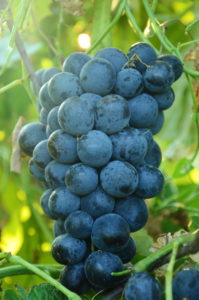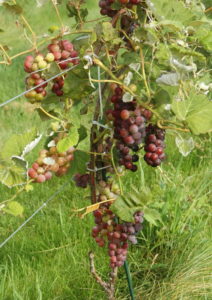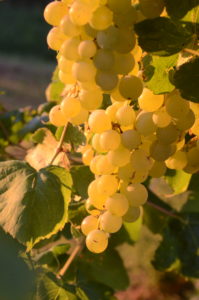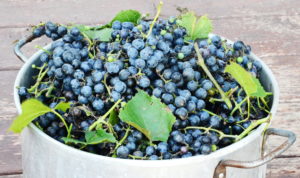
Concord Grapes
If you have ever longed to grow your own fruit, growing grapes is an excellent place to start. Grapes have been cultivated for thousands of years by home gardeners around the world, and you can do it too. They’re easy to grow, and they don’t require you to be an expert gardener or own a vineyard to produce sweet juicy clusters. They are excellent for fresh eating, jams, juicing, and winemaking.

Clusters of red grapes on a two-year-old vine.
Advantages of Growing Grapes
Grapes offer unique advantages over other fruit because they start bearing fruit in just 2 to 3 years, they don’t require a lot of space, they taste so good, plus they add ornamental beauty to your landscape with their splendid fall color. Homegrown grapes have exquisite flavors, that will rival any grape found at your grocer. They are low maintenance, needing little attention, other than an annual pruning, which increases fruit yields and size. They are highly nutritious, packed with antioxidants, vitamins, and minerals supporting eye, cardiovascular and cognitive health. Also, if you sell produce at farmers’ markets, you can add some additional cash to your back pocket, grapes bring top dollar, besides when you prune your vines, consider saving the trimmings to sell at flea markets, they are very popular for making decorative crafts.

Scrumptious Table Grapes
Growing Grapes
There are two basic types of grapes, seeded and seedless, you might ask why would I want to grow seeded grapes? Well, the answer is seeded grapes will outperform seedless, with greater resistance to adverse weather conditions of heat, drought, and cold, ensuring reliable yields when growing conditions are less than ideal. Fresh Eating grapes without seeds is, of course, an advantage, you may want to consider planting some of each to enjoy the benefits that each has to offer.

Sweet White Grapes “Brianna”
Table or Wine Grapes
Grapes are further broken down into categories of table grapes and wine grapes. Table grapes are best for eating fresh, and usually much sweeter than wine grapes, which are designated mainly for winemaking. However, you can grow a table grape for winemaking or a wine grape for fresh eating, depending on you your taste preference. Also, cultivars are classified in terms of when they are ready for harvest, early, mid and late season. For example, in the upper Midwest, early-season grapes like Brianna will ripen the first part of August, Concord mid-season 3-4 weeks later, and golden Muscat a late-season grape will ripen even later. Growing grapes that ripen at different parts of the season is a great way to strategically lengthen your harvest time and enjoy fresh eating for several months.
Start Growing Grapes
Growing grapes is a rewarding experience, it is hard to compare the delight of picking your homegrown sweet juicy clusters to anything else. It just gives you that garden wellbeing feeling, you know what I am talking about, it’s growing it yourself, sustainability, less dependence on society, great tasting quality food, it’s that little piece of heaven that comes with living on a homestead!

Concord Grapes for Jelly
To hear more from Valerie Boese on cooking, keeping chickens, and gardening ideas follow these links:
Slice of Taste Pinterest FaceBook Grit Twitter Tarbox Hollow Poultry











4 Comments
Where is a reliable source of vines to plant, and when is the best time to plant vines in the Midwest?
Easy? Apart from the fact that they can bear earlier than other fruits, I notice no mention is made of the various pests & diseases that affect grapes, many of which frequently require seriously non-organic methods to control. Also the specific pruning one must do at specific times of the year in order to ensure a decent crop.
I have worked in viineyards in several states in Australia for over 15 years and the one thing that defeats a lot of problems that can occur with vines is a proper trellis system. Vines must be kept up off the ground so that the air circulation is such so that it is moving all the time to make it unsuitable for the growth of fungal diseases.
At present I have over a 100 vines in a home orchard situation. I use no chemicals and other than a few Vine Moth caterpillars every year, which cause no harm, I have no other issues.
The article failed to mention the soil quality needed, correct staking, or even the proper planting method to grow grapes successfully. Although the article did have some good information in it, I did not find anything in it that showed how to actually grow them. That would have been helpful.